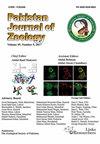利用线粒体基因研究土耳其欧洲狍(哺乳动物:鹿科)的系统发育位置
IF 0.5
4区 生物学
Q4 ZOOLOGY
引用次数: 0
摘要
为了更好地了解土耳其狍子的系统发育位置和进化历史,本研究引入了土耳其阿尔特文一个种群的线粒体DNA序列数据。对4个样本的线粒体DNA细胞色素b (cyt b)和细胞色素c氧化酶亚基I (COI)基因进行了部分测序,并与GenBank中获得的序列进行了分析。cyt b和COI数据集的序列长度分别为1059和646 bp。阿特文地区土耳其狍子种群的核苷酸多样性较低,单倍型多样性较高。共鉴定出2个cyt b单倍型,3个COI单倍型。在检测到的单倍型中,两个cyt b和两个COI单倍型是土耳其特有的。分子系统发育分析;最大似然(ML)、贝叶斯推理(BI)和网络揭示了尚未确定解决的拓扑和进化网络。因此,土耳其狍的单倍型与来自中欧的狍的单倍型交织在一起,而不是形成一个独立的进化分支,而且在基因上也与中欧的单倍型接近。根据进化测年分析,欧洲C. capreolus种群的分化始于更新世初期(约2.72万年)。这一分析还表明,土耳其狍子的分化开始于大约0.58万年。考虑到共有单倍型的存在,土耳其狍子单倍型在ML和BI系统发育树和进化网络拓扑结构中的相对位置,以及该物种内进化分化事件的时间;可以推断出以下结果:(1)与欧洲相同基因型的狍个体也可以在更东的地区发现,如土耳其;(2)在欧洲已知的欧洲狍子种群混合遗传结构的形成和定型过程中,这些遗传结构可能具有一定的代表性;最后,(3)考虑到基于BI分析的进化分化时间,狍种群可能是从欧洲进入土耳其的。本文章由计算机程序翻译,如有差异,请以英文原文为准。
Insight into the Phylogenetic Position of Capreolus capreolus, the European Roe Deer, (Mammalia: Cervidae) from Turkey using Mitochondrial Genes
For contributing to a better understanding of the phylogenetic position and evolutionary history of Turkish roe deer, mitochondrial DNA sequence data belonging to a population from Artvin, Turkey were introduced by this study. The cytochrome b (cyt b ) and cytochrome c oxidase subunit I (COI) genes of mitochondrial DNA belonging to the four samples of Capreolus capreolus were partially sequenced and analyzed alongside the sequences obtained from GenBank. The cyt b and COI data sets included sequences that were 1059 and 646 bp long, respectively. The Turkish roe deer population in Artvin had a relatively low nucleotide diversity and high haplotype diversity. A total of two haplotypes were identified for cyt b , while three haplotypes were identified for COI. Of the haplotypes detected, two cyt b and two COI haplotypes were specific to Turkey. Molecular phylogenetic analyses; Maximum Likelihood (ML), Bayesian Inference (BI), and Network revealed topologies and evolutionary networks which were not definitely resolved. Consequently, Turkish roe deer haplotypes were intertwined with the roe deer haplotypes from Central Europe instead of forming an independent evolutionary clade, and were also, found genetically close to Central European haplotypes. According to the evolutionary dating analysis, the divergence of C. capreolus populations in Europe started at the beginning of the Pleistocene (approximately 2.72 mya). This analysis also demonstrated that the divergence of Turkish roe deer began at approximately 0.58 mya. Given the existence of, shared haplotypes, the relative positions of Turkish roe deer haplotypes in the topologies of the ML and BI phylogenetic trees and evolutionary networks, and the times of evolutionary divergence events within this species; the following results may be inferred: (1) roe deer individuals with the same genotype as those in Europe can also be found in areas further east, such as Turkey; (2) these could be considered to be representatives, which may have contributed to the formation and shaping processes of the known admixed genetic structure of European roe deer populations in Europe; and finally, (3) the roe deer populations may have probably entered Turkey from Europe when evolutionary divergence times based on BI analysis are considered.
求助全文
通过发布文献求助,成功后即可免费获取论文全文。
去求助
来源期刊

Pakistan Journal of Zoology
生物-动物学
CiteScore
1.10
自引率
16.70%
发文量
306
审稿时长
4.5 months
期刊介绍:
Pakistan Journal of Zoology (Pakistan J. Zool.) publishes original articles in English on all aspects of animal life. Generally these articles will be in, or related to one of the following subject areas: Physiology, Cell Biology, Molecular Biology, Genetics, Bioinformatics, Toxicology, Forensic Science, Developmental Biology, Entomology, Parasitology, Microbiology, Biotechnology, Pathology, Palaeontology. Taxonomy, Environmental Biology, Wildlife, Fisheries, Vertebrate and Invertebrate Morphology. Additionally, the journal considers research on health and clinical studies. Short communications are regularly considered, however, uninvited review articles, first records/reports of known species, case reports/studies and survey reports are not published in Pakistan Journal of Zoology.
 求助内容:
求助内容: 应助结果提醒方式:
应助结果提醒方式:


